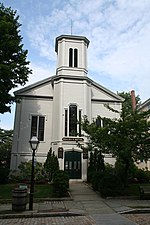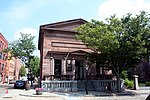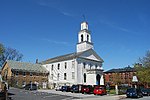United States Customhouse (New Bedford, Massachusetts)
1834 establishments in MassachusettsBuildings and structures in New Bedford, MassachusettsCustom houses in the United StatesCustom houses on the National Register of Historic PlacesGovernment buildings completed in 1834 ... and 10 more
Government buildings on the National Register of Historic Places in MassachusettsGreek Revival architecture in MassachusettsHistoric district contributing properties in MassachusettsIndividually listed contributing properties to historic districts on the National Register in MassachusettsNRHP infobox with nocatNational Historic Landmark District contributing propertiesNational Historic Landmarks in MassachusettsNational Register of Historic Places in New Bedford, MassachusettsRobert Mills buildingsUse mdy dates from August 2023

The United States Customhouse is a historic and active custom house at 2nd and William Streets in New Bedford, Massachusetts. Architect Robert Mills designed the custom house in 1834 in a Greek Revival style. It has been used by the U.S. Customs Service ever since, and today serves as a port of entry.The building was designated a National Historic Landmark and added to the National Register of Historic Places in 1970 for its architectural significance as one of the finest modest Greek Revival government buildings in New England.
Excerpt from the Wikipedia article United States Customhouse (New Bedford, Massachusetts) (License: CC BY-SA 3.0, Authors, Images).United States Customhouse (New Bedford, Massachusetts)
Acushnet Avenue, New Bedford
Geographical coordinates (GPS) Address Nearby Places Show on map
Geographical coordinates (GPS)
| Latitude | Longitude |
|---|---|
| N 41.635277777778 ° | E -70.924722222222 ° |
Address
Acushnet Avenue
02740 New Bedford
Massachusetts, United States
Open on Google Maps









